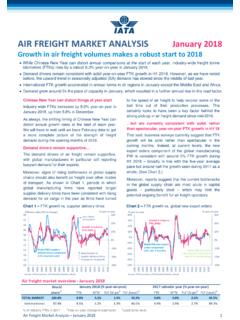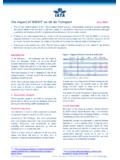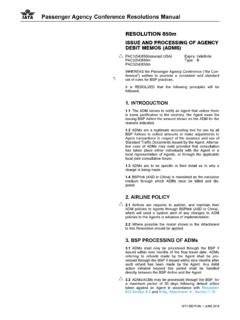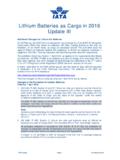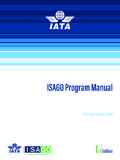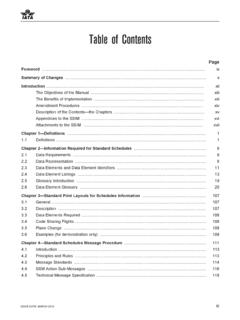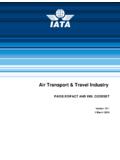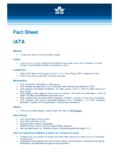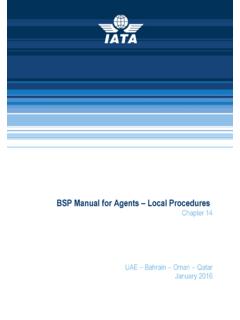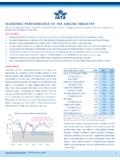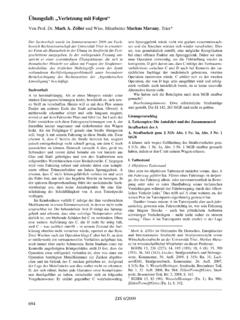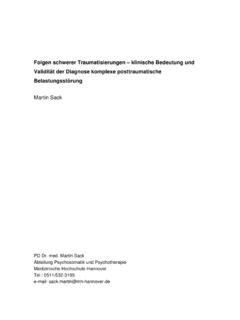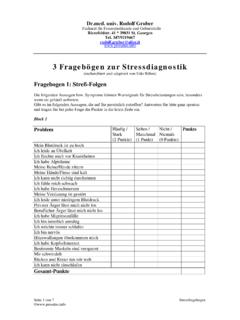Transcription of The impact of ‘BREXIT’ on UK Air Transport June 2016
1 iata Economics: All use of this report is subject to the Terms & Conditions of Use available here The impact of brexit on UK Air Transport June 2016 The UK has voted to leave the EU the so-called brexit scenario. Considerable uncertainty remains regarding the precise detail of the exit and it could be 2 years or more before these issues are fully resolved; prolonged uncertainty will influence both the magnitude and persistence of the economic impacts. Preliminary estimates suggest that the number of UK air passengers could be 3-5% lower by 2020, driven by the expected downturn in economic activity and the fall in the sterling exchange rate. The near-term impact on the UK air freight market is less certain, but freight will be affected by lower international trade in the longer term. A big issue is with aviation regulation. The UK faces a trade-off between accessing the European Single Aviation Market and having the policy freedom to set its own regulations.
2 Introduction In the referendum held yesterday, the UK voted to leave the European Union; the so-called brexit scenario has become reality. This decision has wide-ranging impacts throughout the UK and, to a lesser extent, more broadly through Europe and beyond. This note focusses on the implications for the UK air Transport sector, considering both the economic and regulatory impacts in turn. As for any significant policy decision, the details are critical, and with many of these still to be determined in the case of brexit , the analysis that follows is necessarily preliminary in nature. 1. Economic Impacts The immediate impact on air traffic will be governed by the effect of brexit on two key variables: economic activity and the sterling (GBP) exchange rate. Analytical framework The referendum result is widely expected to present a significant negative shock to the UK economy.
3 According to HM Treasury,1 the most pronounced near-term impacts derive from heightened uncertainty causing businesses and households to delay spending and investment decisions, as well as transmission via financial channels. There is a wide range of estimates of the economic impact that brexit will have in the short term. A number of these are summarized in the table below. 1 See Figure 1: impact of brexit on the level of UK GDP * up to mid-year 2018, after 15 years Impacts vary according to the different scenarios and assumptions used, but broadly point to UK GDP being lower in level terms by 2020 compared to the no brexit baseline. It is worth noting that the impact of brexit is expected to be a permanent downward shift in the level of GDP, not a temporary impact that is recovered after a period of time.
4 Income elasticities Estimates of the elasticity between income (proxied by GDP) and air travel demand vary for example, between developed and emerging markets but are consistently positive and greater than one. Developed markets are estimated to have an income elasticity of at a national It may be that a simple income elasticity approach picks up other factors that affect demand for air travel over the long run, such as trade openness etc. Consequently, a conservative approach would be to use a unit elasticity between GDP and air travel in the near term (as a measure of underlying demand). 2 See Scenario201820202030HM *Severe * range iata Economics: All use of this report is subject to the Terms & Conditions of Use available here Figure 2: UK GDP vs air passengers (%yoy growth) Exchange rate impacts Sterling fell sharply in volatile trading conditions following the result, broadly in line with expectations.
5 The general view amongst analysts is that it will recover somewhat over the medium to longer term. Nonetheless, the currency is expected to remain weaker than otherwise would have been the case under a no brexit scenario (in the region of 10-15%). The impact that this would have on air travel is more clear-cut than the economic effects. The weaker pound has immediately made outbound trips for UK inhabitants more expensive (because a given amount of GBP will now buy less goods and services overseas). At the same time, for overseas visitors to the UK, their local-currency earnings will now stretch further than they did All told, the short-term movement in sterling will affect purchasing power immediately and, over time, will serve to discourage outbound travel by residents and to encourage inbound trips by foreigners. The precise effect of the GBP depreciation on air Transport hinges on two key variables: a) The inbound/outbound shares of air travelers.
6 All else equal, if traffic on a given market is split equally between inbound and outbound travelers, the outbound residents who would be discouraged to travel abroad by the weaker exchange rate would be entirely offset by the additional inbound traffic encouraged by their increased purchasing power. b) The sensitivity of inbound and outbound air travelers to the exchange rate. The exchange rate affects the price of overseas travel. The literature suggests a price elasticity in the region of (ie, a 10% increase in the price of travel 3 See (Dec%202015).pdf would, all else equal, correspond with a 7% decrease in outbound traffic). While the exact impact would depend on exchange rate developments in 3rd party currencies, the inbound elasticity is likely to be higher, as a weaker GBP has raised the attractiveness and affordability of the UK relative to other In passing, while the discussion above holds overall, the GBP will not move by the same magnitude against all currencies, leading to different impacts.
7 Also, there are typically lags between significant exchange rate shifts and this being reflected in the pattern of passenger travel as trips are typically planned some months in advance. These factors complicate but do not invalidate the more straightforward assessment noted above. UK dominated by outbound traffic The UK air market is dominated by outbound traffic, with such traffic accounting for just over two-thirds of total flows (in 2015 there were million visits overseas by air by UK residents, compared to visits to the UK by overseas residents). The table below shows the estimated impact of weaker sterling, based on the forecast profile from the HM Treasury analysis, over the next two years. Figure 3: Exchange rate impact on UK air passengers* * Both scenarios apply a 12% devaluation & an In/Out-bound market share of 33% and 67%, respectively.
8 Case A shows the estimated impact if inbound and outbound traffic flows are assumed to exhibit the same price elasticity of In this case, the movements in the exchange rate discourage (encourage) outbound (inbound) travelers by the same degree, but the fact that the market is weighted towards outbound means that this impact dominates. Overall, in Case A, the weaker exchange rate is expected to correspond with a net reduction in traffic of around 3%. Case B examines a scenario more in keeping with what we would expect in which the elasticity for inbound passengers is higher than that for outbound ( versus ). In this case, inbound demand is encouraged more than outbound is deterred. 4 Note that the elasticities will vary across individual markets.
9 For example, primarily leisure markets will be more price sensitive (a higher price elasticity) than primarily business markets. InboundOutboundInboundOutboundNetCase elasticitiesEst. impacts on air traffic iata Economics: All use of this report is subject to the Terms & Conditions of Use available here As a result, despite representing around of total traffic on the route, the higher sensitivity helps to offset the negative impact on the larger outbound traffic part of the market, and the net impact on total traffic is reduced. Estimated impact on the UK air passenger market The direct economic impact is likely to see the UK air passenger market be 3-5% lower by 2020 than the no brexit baseline. In other words, the outcome of yesterday s referendum could reduce air passenger growth by percentage points each year over the near term. By contrast, the impact of weaker sterling on UK air traffic is likely to be relatively muted.
10 This relates to the fact that we expect the weaker exchange rate to stimulate inbound demand to the UK to a greater extent than it deters outbound trips. As a result, despite inbound traffic accounting for a minority of traffic in the entire market, this will, in part, offset the negative impact on outbound travel. Comparison with previous economic shocks Figure 4 depicts the GDP and air passenger impacts of previous adverse economic shocks; the UK s decision to exit the European Exchange Rate Mechanism (ERM) in the early 1990s and the global financial crisis (GFC). Figure 4: impact of past events on UK GDP & air travel The expected GDP shock associated with brexit is broadly comparable to that which followed the ERM exit, with a similarly-sized fall in the sterling exchange rate expected too. But whereas real GDP had recovered to its pre-recession peak within 11 quarters in the early-1990s, the recovery following brexit is estimated to be longer and shallower.
